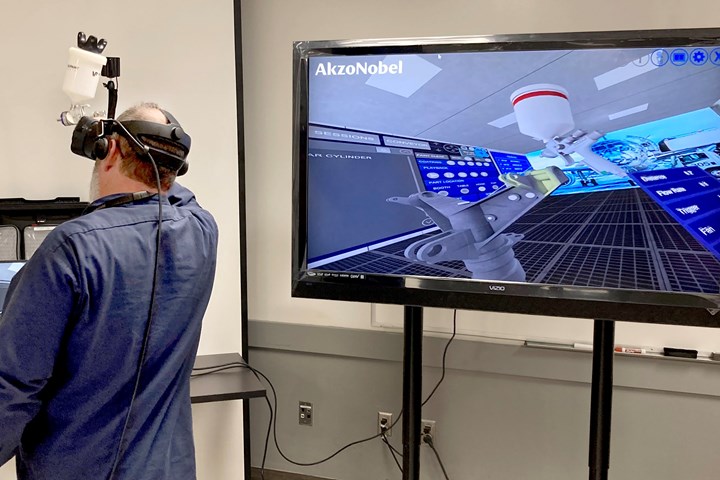AkzoNobel Uses VR for Training Airline Apprentices
The virtual reality technology provides a paint booth and spray gun that enables trainees to work and master their skills without losing parts in the process.

Wearing the VR headset, a man is simulating painting a real life part through the VR platform without ever spraying an actual drop of paint. Photo Credit: AkzoNobel
AkzoNobel Aerospace Coatings is partnering with American Airlines to deliver a new way of training apprentice painters, and upskilling existing teams, through the use of a virtual reality (VR) technology. The technology is said to be a more efficient and sustainable training process than the airline’s previous training regimes.
The VR platform mimics a customer’s production environment and multiple coating systems to train teams virtually. A VR headset immerses the American Airlines’ trainee in a virtual paint booth, complete with the aircraft part to be coated.
The system can be programmed with various paint specifications (such as the thickness of the coating required) and, as the operator uses the spray gun, they can see whether too much or too little paint is used and look for inconsistencies in the way the coating is being applied.
Meanwhile, the operator’s core skills are measured, from setting up the spraying session to the distance, angle and speed at which the gun is used. The feedback is immediate, so trainees can react quickly and change their technique to become more consistent. It shows where runs and sags occur, where the wet film thickness is not sufficient or where the coverage is inadequate to deliver a smooth finish. It also helps them avoid common problems, such as paint overlap.
For American Airlines, a very specific part of the aircraft — a nose landing gear cylinder — was programmed into the system. A cohort of 13 painters with varying abilities were then encouraged to spray the part — without a single drop of real paint being used.
Terry Lesperance of American Airlines describes the AkzoNobel VR solution as an efficient, safe way to train his team. “In a spray booth, we’d have to spray the primer, then let it dry, then measure the results to see how they did — all of which takes time,” Lesperance says. “If we were training 13 painters, we’d also have to have 13 nose landing gear cylinders available to paint.
“With VR, we don’t have any of these challenges. I can train more painters, more quickly, and allow them to make mistakes without it costing me anything.”
AkzoNobel’s technical services team supported Lesperance with the training, physically suiting up and using the booth to share their experience and their technique with American Airlines’ new painters. Even for experienced painters, there are real benefits, the company says. A painter may have been using a polyurethane paint and need to switch to a Teflon paint or use a paint with a different mix that may be heavier or lighter, and all of this can be programmed into the system to replicate the experience in the spray booth.
Matthew Amick, global technical services manager at AkzoNobel Aerospace Coatings, says the integration of VR into American Airlines’ training regimen is an example of how it is supporting its customers with meaningful, practical help.
“Typically, when a customer asks for training, we have to provide significant quantities of paint, much of which is wasted,” Amick says. “By effectively moving the spray booth into the classroom, we completely eliminate waste, reduce costs and unnecessary shipping, and prevent volatile organic compounds (VOCs) from being released. There are also no costs associated with cleaning the spray guns, or the additional VOCs releases from the solvents required, or providing the panels needed for wet paint training. It’s a ‘win win’ for all involved.”
Lesperance will be looking at training more of his team in 2023, with AkzoNobel in support. “It’s a very high quality of training,” Lesperance concludes, “and I’m looking forward to getting more of my team.”
Originally trialed at AkzoNobel’s training center in Troy, Michigan, several portable units are available for use at a customer’s own premises.
Related Content
PPG, Satys Partner for Aerospace Ecoat System in France
PPG is partnering with Satys, a French industrial group active in aircraft sealing, painting and surface treatment.
Read MoreAerospace Conductive Coating Provides Adhesion, Fluid Resistance
Conductive coating (CM0485115) provides a high-conductivity solution for dissipating static on aluminum and composite aircraft.
Read MoreAnodizing for Bonding Applications in Aerospace
Anodizing for pre-prep bonding bridges the gap between metallic and composite worlds, as it provides a superior surface in many applications on aluminum components for bonding to these composites.
Read MoreTop Shop Emphasizes Dedication, Work Ethic
With a primary focus on aerospace and defense work, American Metaseal Corp. of Arbutus, Maryland, has qualified as a Top Shop on multiple occasions.
Read MoreRead Next
How Artificial Intelligence Will Revolutionize Your Business
11 predictions of how AI and related technologies will revolutionize finishing in the next 10 years.
Read MoreDemystifying Artificial Intelligence
Head to your next team meeting with just enough AI knowledge to be the “expert” and launch your journey.
Read MoreTrends in Industrial Coatings
The benefits of new technologies in the industrial coatings market.
Read More













.jpg;maxWidth=300;quality=90)









